Huddersfield Corporation Tramways
History
After initialling supporting a scheme promoted by the London Tramways & General Works Company to build a tramway within the town, Huddersfield Corporation suddenly got cold feet, withdrawing its support and thereby causing the company's 1877 bill to fail. Although this was ostensibly due to the company having failed to consult all the council stakeholders, it seems more likely that the council simply had second thoughts about allowing a private company to own and operate a tramway within its town.
The corporation subsequently set about planning its own scheme for an extensive tramway system, obtaining the necessary powers on the 2nd August 1880, under the Huddersfield Improvement Act 1880. The act approved the construction of 19.77 miles of tramway, which could be worked by either animal, steam or mechanical power, the latter subject to approval by the Board of Trade (for the first seven years and at seven-year intervals thereafter). Although horse traction had been authorised, the corporation knew that its use, other than on flat stretches of line, was unrealistic in such a hilly town.
Although construction commenced in 1881, it was clear to the corporation that they would not be able to complete the system in the timeframe permitted by the 1880 act. More worryingly, however, was their inability to find a lessee, municipal authorities being forbidden from operating tramways by the Tramways Act of 1870. With this in mind, the corporation wisely applied for powers to extend the time allowed for construction, including adding another 0.9 miles of tramway, as well as seeking dispensation to work the tramway themselves. These powers were granted on the 18th August 1882 under the Huddersfield Corporation Act 1882 .
Parliament was, however, clearly not happy with the situation, grudgingly permitting the corporation to operate the system itself, but only for as long as no lessee came forward, and also subject to the judgement of the Board of Trade that no reasonable offer had been turned down. With all this in mind, the corporation certainly made an effort to find a lessee, advertising in national journals, but all in vain, the only offers being for the odd line rather than the entire system. As a consequence, history was made on the 11th January 1883 with the opening of the first line — between Lockwood and Fartown — the first municipally operated tramway service in the British Isles. The service was initially provided by a solitary steam tram.
The tramway was built to the unusual gauge of 4ft 7¾ins, to facilitate the use of railway wagons, though there is little evidence that the corporation ever did so.
Further lines followed between the 9th June 1883 and the 9th May 1885, bringing the initial burst of construction to an end. The last of these lines to open, Moldgreen, was operated by horse traction, part of the route being unsuitable for steam traction until road widening had taken place, the steamers only taking over some three years later on the 2nd April 1888. Further lines were added in 1886, 1888, 1889 and 1890, by which time the corporation had 18 steam trams at its disposal.
Powers for further tramway lines were obtained on the 4th July 1890 under the Huddersfield Tramways and Improvement Act 1890, following which the system was continually extended between 1891 and 1896 — including significant relaying of the track on the older lines — by the end of which it totalled 19.56 miles, operated by a fleet of 32 engines. The following year, the corporation, with the legal landscape around municipal operation of tramways having changed, successfully obtained powers to operate the tramway permanently; these were granted on the 3rd June 1897 under the Huddersfield Corporation Act 1897. Perhaps more importantly, however, the act also included approval to operate the system electrically, the corporation having evidently given consideration to the next stage of the system's evolution.
Around the same time, the corporation also struck an agreement with Linthwaite Urban District Council — a neighbouring authority — to construct an extension of the system that would take the trams out beyond the borough boundary to Slaithwaite. Powers for an additional 2.62 miles of tramway out to the borough boundary, were obtained by the corporation on the 2nd August 1898, under the Huddersfield Corporation Tramways Order, this passing into law as part of the Tramways Orders Confirmation (No 2) Act 1898. The same act also approved the Linthwaite Tramway Order, which gave Linthwaite UDC powers to build the 3.01 miles of tramway within its boundary.
With the opening of the lines to Slaithwaite and Longwood on the 21st May 1900, the steam-tram system reached its final size of 26.67 miles. From Huddersfield, lines radiated: southwards to Newsome and Berry Brow; southwestwards to Crosland Moor and Slaithwaite; westwards to Longwood and Outlane; northwestwards on a circular route through Lindley, Edgerton and Oakes to join the Outlane line; northwards to Birkby and Fartown (also joined by an east-west line); northeastwards to Bradley; eastwards to Waterloo; and southeastwards to Almondbury. Although the steam trams would also briefly operate the new electric line out to Sheepridge, this was only a temporary measure until electric services were instituted, the steam system having already shrunk appreciably by this time (1902).
By the late 1899, plans for converting the system to overhead electric traction — involving much doubling of the existing system and significant extensions to it — were well advanced, construction work commencing in early 1900. Later that year (on the 6th August), powers were obtained to build an additional 23.44 miles of tramway under the Huddersfield Corporation Tramways Act 1900 and the Huddersfield Corporation Tramways Order 1900, the latter authorised by the Tramways Orders Confirmation (No 1) Act 1900.
The system was converted and extended in two phases between 1901 and 1902. The first electric services ran on the Outlane line and the Lindley Circular line on the 14th February 1901, with the Crosland Moor, Slaithwaite and Longwood lines following later that month. There now followed a hiatus, the second tranche of lines — Waterloo, Newsome, Fartown, Sheepridge, Birkby, Almondbury, Honley and Bradley — opening in short order between the 15th May and the 13th July 1902. The new system, which was operated by 61 electric tramcars, brought 19 years of steam operation to a close, the last steam tram running on the 21st June 1902.
The corporation now set about operating the tramway as efficiently as it could, obtaining a further 9 cars in 1903, and securing powers for a small number of lines (circa 0.5 miles) that would improve tramcar movement. The latter were granted on the 11th August 1903 via the Huddersfield Corporation Tramways Order 1903, which was approved by the Tramways Orders Confirmation (No 1) Act 1903.
Between 1904 and 1905, the Longwood line was extended a short way to the Rose and Crown Inn, and a handful of sidings were built into mills, the latter to enable the delivery of coal by tramway, the corporation purchasing two electric coal trucks for this service. The corporation also commenced top-covering its fleet of open-topped cars, as well as introducing a series of cross-town services, which were so successful that only two lines were operated as out and back shuttles.
Powers for an extension of the Crosland Moor line from Park Road to Dryclough Road were obtained via the Huddersfield Corporation Tramway Order 1900, which was authorised on the 2nd August 1907 by the Tramways Orders Confirmation Act 1907. The 0.85-mile extension opened just under two months later on the 27th September 1907.
During 1908 and 1909, the corporation sought to improve the service further, continuing its top-covering programme, carrying out significant track doubling, and obtaining another six tramcars, the latter being top-covered from new. The corporation also continued its policy of building short extensions to existing lines, powers for 1.46-miles of tramway being obtained on the 3rd August 1910 under the Huddersfield Corporation Tramways Order 1910, which was approved as part of the Tramways Orders Confirmation Act 1910. This allowed the corporation to extend the Newsome line from Stile Common to the church, and the Lindley circular line from the junction of Holly Bank Road and Halifax Road to Birchencliffe, both opening in 1911. The latter resulted in the abandonment of the circular service, the line along Hollybank Road eventually being removed.
The year before these lines opened, the corporation had finally given up complaining about the state of the track owned by Linthwaite UDC, which had been badly neglected, necessitating a reduction in services. An offer was made to purchase the tramway, which was accepted, the corporation purchasing the line between Pinfold and Slaithwaite in August 1910, relaying it with new track and doubling it, all by October 1910.
The corporation's thoughts now turned to how the system could be profitably expanded, as well as to the experimental use of other modes of transport, namely, motorbuses and trolleybuses. This resulted in powers being obtained to build 8.5 miles of tramway — serving Brighouse, Elland, Marsden, Mirfield, Crosland Hill and Kirkheaton Station — to operate motorbuses anywhere within the borough, and trolleybuses on a single route (New Hey Road). Although these powers were granted on the 15th August 1913, under the Huddersfield Corporation Act 1913, the Great War would prevent any forays into motorbus and trolleybus operation.
The extensions to Elland, West Vale and Marsden were opened between January and October 1914, with much track doubling also being accomplished. This and the thirty new cars purchased between 1912 and 1914 saw the system much better placed than others to withstand the rigours of the Great War. Nevertheless, the system inevitably deteriorated over the four years from the heavy loadings, and the greatly reduced maintenance, the latter due to loss of men (and their skills) to the armed forces, and government restrictions on new materials and spares. Despite the latter, the department still managed to obtain permission to order six new cars in 1917, though it was to be two years before they were delivered.
Following the end of the conflict, the corporation quickly set about putting the system in order, another 14 tramcars arriving in 1920 and a small extension of the Longwood line (to Dod Lea Lane) opening on the 13th April. Perhaps the best evidence for the commitment of the corporation to its tramway was the building of a brand-new 100-car tramway depot at Longroyd Bridge, which opened on the 1st July 1921.
The long-planned line out to Brighouse via Rastrick was finally opened on the 12th March 1923, bringing the tramway system to its maximum extent of 39.12 miles, all of which was serviced by a fleet of 140 trams. From Huddersfield, lines radiated: southwards to Newsome and Honley; southwestwards to Crosland Moor and Marsden; westwards to Dod Lea and Outlane; northwestwards to Lindley and West Vale; northwards to Birkby, Sheepridge and Brighouse; northeastwards to Bradley; eastwards to Waterloo; and southeastwards to Almondbury. Although the Huddersfield system came close to that of Halifax Corporation Tramways at West Vale and Brighouse, the systems were never connected due to the difference in gauges, 4ft 7¾ins versus 3ft 6ins.
The first truly modern, totally enclosed tramcars, arrived in 1924 (10 in total), with another 8 being acquired in 1931/2, though these were to be the last.
The corporation finally ventured into motorbus operation in early 1920, primarily using them as feeders to the trams, but gradually expanding them beyond these confines during the 1920s.
Although tram track replacement continued as before, the corporation was, by 1930, keen to finally try its hand at trolleybus operation as an alternative option to replacing life expired tram track. This did not, however, prevent it from approving major expenditure on track laying as late as 1932.
Powers to replace the trams on the Almondbury line were obtained on the 22nd December 1932 under the Public Works Facilities Scheme (Huddersfield Corporation) Confirmation Act 1932. The corporation, as forward-thinking as ever, also obtaining powers, subject to the approval of the Minister of Transport, to run trolleybuses anywhere in the borough it saw fit. The last trams on the Almondbury line ran on the 16th April 1933, services being temporarily taken over by motorbuses until the first trolleybuses were ready to enter passenger service, the ceremonial opening taking place on the 4th December 1933.
Further powers were obtained on the 28th March 1934, under the Public Works Facilities Scheme (Huddersfield Corporation) Confirmation Act 1934. This was quickly followed by the withdrawal of trams on the Outlane, Lindley and Waterloo lines, all of which were in need of track renewal; the new trolleybuses taking over on the 11th November 1934.
The trolleybuses were clearly a success, the Tramways Committee recommending — in April 1935 — that the entire tramway system be converted to trolleybus operation, at which time the Tramways Department was operating 111 trams and 30 trolleybuses. Powers for further trolleybus routes, as well as to abandon the tramway, were granted on the 14th July 1936, under Huddersfield Corporation (Trolley Vehicles) Act 1936
The following year, in June 1936, the name of the undertaking was changed to Huddersfield Corporation Passenger Transport, to better reflect the different modes of transport provided. There now followed a gradual replacement of the trams, Birkby, Crosland Moor and Newsome succumbing in 1937, Bradley, Marsden and Sheepridge in 1938, and Longwood, Dod Lea and West Vale in 1939. This just left the Brighouse line, on which the last tram of all ran on the 29th May 1940, bringing 57 years of municipal tramway operation to an end.
Whilst financial details of the enterprise are as yet un-researched, the fact that the corporation continually and heavily invested in its tramway system, and major sums were diverted to rates relief, strongly suggest that it was very profitably operated.
Uniforms
Staff working the horse-tram services on the Moldgreen route (between 1885 to 1888) wore smart but informal attire, jackets, shirts and ties, along with trousers, and the ubiquitous bowler hat, a form of headgear much favoured by horse-tram crews throughout the country, at least up until the late 1890s.
Steam tram drivers (and stokers) wore typical railway footplate clothing (cotton jackets and trousers) with cloth caps (without badges). Conductors initially wore identical attire to their horse-tram counterparts, but some time in the early 1890s, the corporation evidently decided to issue uniforms. Jackets were single-breasted with four buttons (probably marked with the system title — see link) and lapels, and were cut away at the bottom. Caps were in a kepi style and carried an oval badge of unknown pattern, probably of embroidered cloth, though they could have been of metal with a leather inlay (photos show a much darker appearance in the centre). The badge probably bore an employee number in the middle.
For the inauguration of electric services, staff were provided with single-breasted jackets with four buttons, and lapels, totally devoid of insignia. Caps were initially in a kepi style, and carried a large oval cap badge of unknown pattern, almost certainly in brass to match the buttons (see link), though a change was subsequently made — around 1903/4 — to a more modern style of peaked cap with a tensioned crown. In the late-Edwardian era (around 1907/8), a new style of single-breasted jacket was introduced with five buttons, breast pockets, stand-up collars and epaulettes. The collars bore 'H C T' system initials in individual brass letters on the bearer's right-hand side, and an employee number (in individual brass numerals) on the left-hand side; the epaulettes had a button fastening at the neck end, and bore a small brass municipal-device badge (see below). At the same time, the large oval cap badge was dispensed with, being superseded by a standard, off-the-shelf, script-lettering grade badge — either 'Motorman' or 'Conductor' — with the municipal-device badge worn above. Soon afterwards, motormen appear to have been switched to a double-breasted, lancer-style of tunic with five pairs of buttons — narrowing from top to bottom — stand-up collars and epaulettes; the collars and epaulettes carried the same insignia as conductors' jackets.
A final change was made to the uniform in the 1930s, when both conductors and motormen were issued with a more modern cut of double-breasted jacket with four pairs of buttons, lapels and epaulettes; the insignia were identical to those worn previously, but with the badges and buttons almost certainly in chrome rather than brass. From 1936 onwards, when the name of the undertaking was changed to Huddersfield Corporation Passenger Transport, uniforms would almost certainly have borne 'HUDDERSFIELD TRANSPORT' buttons (see link).
Conductors and motormen were also issued with double-breasted greatcoats; photographs suggest that these garments bore no badges.
In the steam era, inspectors wore single-breasted jackets with lapels, similar to those issued to conductors, but with slit pockets; no badges of any kind adorned the jackets. Like the conductors, a kepi-style cap was worn, seemingly with the same style cap badge (possibly bearing an employee number), but with a pom pom on the top. In the electric era, a change was made to more traditional single-breasted jackets with hidden buttons (or more likely a hook and eye affair), edged in a different and finer material than the main jacket. Caps were either of the kepi or drooping-peak type (the surviving photographs are unclear), and were worn long after tramcar staff had switched to tensioned-crown peaked caps; inspectors' caps probably carried an embroidered script-lettering grade badge, 'Inspector'. In later years, inspectors may have been issued with more modern single-breasted jackets with lapels — evidence is, however, currently lacking — though they certainly switched to tensioned-crown peaked caps prior to the closure of the system.
In common with the vast majority of UK tramway systems, female staff were employed during the Great War to replace tramwaymen lost to the armed services. The conductresses were issued with tailored, single-breasted jackets with five buttons, two breast pockets, a waist belt, epaulettes and high, fold-over collars, the latter being fastened down in an unusual manner by buttons at each side. The epaulettes usually bore the standard municipal-device badge, though photographs also show them left plain. A long matching skirt was also worn, along with a baggy cap with a glossy peak, which became known as a motor cap; although the caps sometimes bore the standard municipal-device badge, and occasionally a script-lettering grade badge, invariably the ladies chose to substitute these for military badges. This was common practice amongst tramway personnel the length and breadth of the country during the Great War, to show solidarity with loved ones who were away serving in the armed forces. Straw bonnets were also issued, almost certainly for use in summer, and these carried the grade — 'CONDUCTOR' — in embroidered block letters on a hat band (see below).
Women were also employed as tram conductresses during the Second World War, though only briefly, as the last tram ran on 29th June 1940. These ladies were issued with what appear to have been one-piece, full-length smocks, which were presumably worn over their own skirts and blouses; they were single-breasted with five buttons and lapels that bore 'H C T' metal system initials on the right-hand side, and an employee number on the left-hand side. Headgear appears to have taken the form of a small beret, which was kept in place with a hat pin; the beret almost certainly carried the Huddersfield municipal-device badge. The use of the smocks and the beret is, to the best of my knowledge, unique amongst British and Irish tramway systems.
My thanks go to Stephen Howarth and Stephen Lockwood for many of the photographs and much of the background information.
Further reading
For more information on Huddersfield's tram system, see: 'The Tramways of Huddersfield' by Roy Brook; The Advertiser Press Ltd (1959).
Images
Horse tram drivers and conductors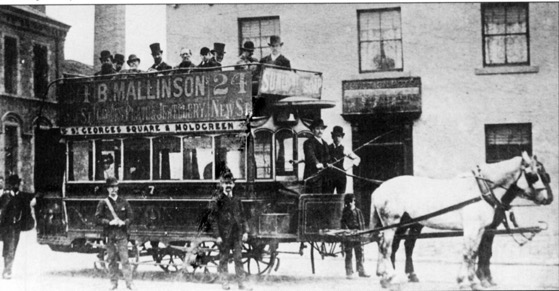
Horse Tram No 7 outside the Junction Hotel at Moldgreen — May 1885, no doubt at or shortly after the official inauguration of the service. All present are in smart but informal attire, a situation that also applied to staff working the steam services in the early years of the system. Photo courtesy of the Tramways and Light Railway Society, with thanks to David Voice.
Steam tram drivers and conductors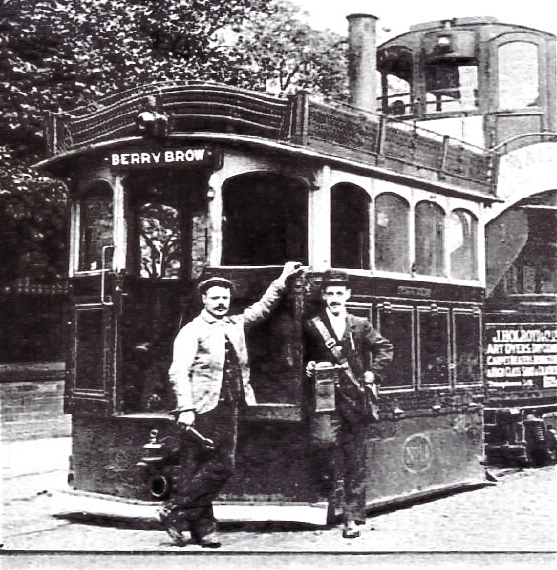
Kitson Steam Tram No 14 and crew on a Berry Brow service in Lockwood Road — photo undated, but possibly taken around the time this line was opened in June 1892. Photo courtesy of the Tramways and Light Railway Society, with thanks to David Voice.
An enlargement of the above photograph showing the driver (Ernest Pogson) and his conductor. The latter, who is holding a brass fare collection box, is wearing a kepi-style cap, bearing an oval cloth cap badge, and a single-breasted uniform jacket.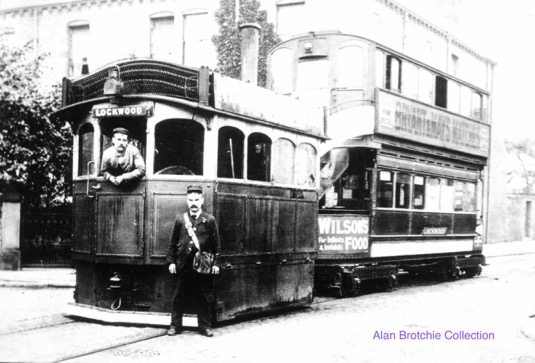
An unidentified Kitson Steam Tram and its crew on a Lockwood service in Norman Avenue — photo undated, but probably taken in the mid-to-late 1890s.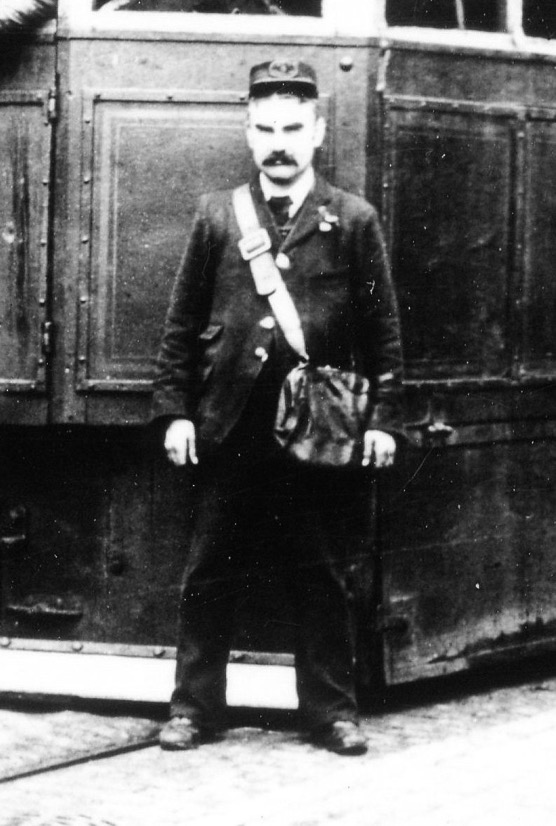
An enlargement of the above photograph showing the conductor, who is wearing a single-breasted uniform jacket and a kepi-style cap, the latter bearing what would appear to be an embroidered cap badge.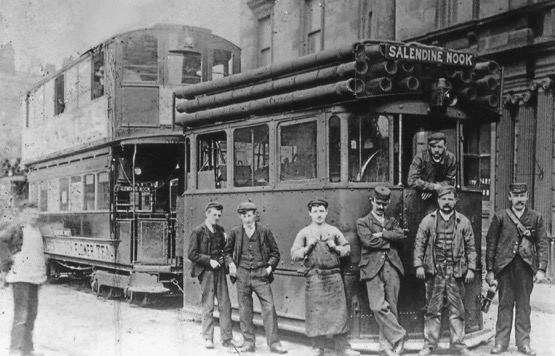
A number of tramway staff pose for the camera, possibly in Railway Street, with an unidentified Thomas Green & Sons steam tram on a service to Salendine Nook — photo undated, but probably taken in the late 1890s. Author's Collection.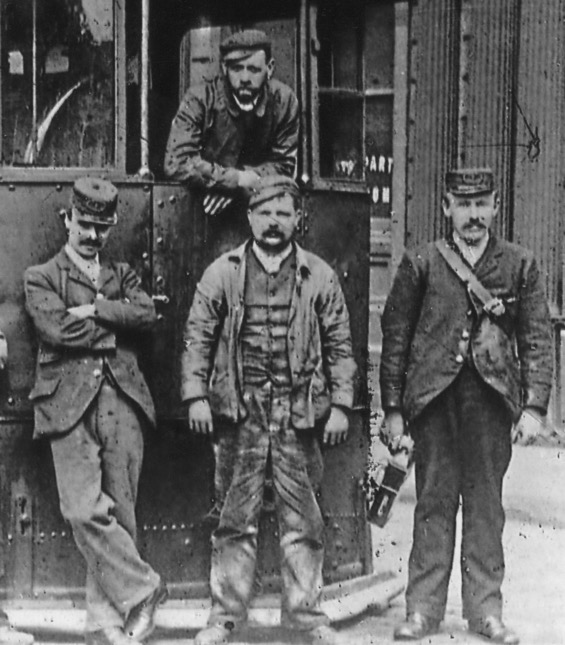
An enlargement of the above photograph showing some of the tramwaymen, from left to right: an inspector, a driver, a stoker (or another driver) and a conductor (the latter with fare collection box in hand). The driver and the stoker are wearing typical railway footplate-like attire, whilst the conductor is clearly wearing a uniform jacket with a kepi-style cap bearing an embroidered cap badge.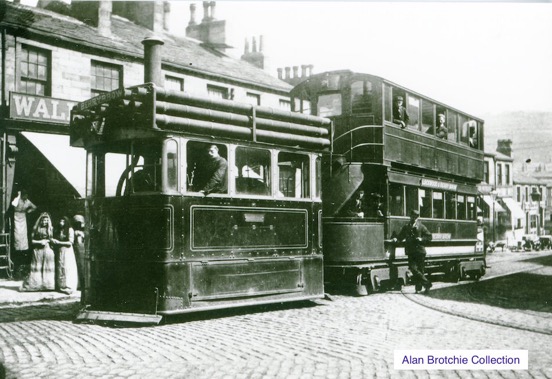
Huddersfield Steam Tram No 25 (a Thomas Green & Sons product of 1892) in Bridge Street, Lockwood Bar — photo undated, but probably taken in the late 1890s.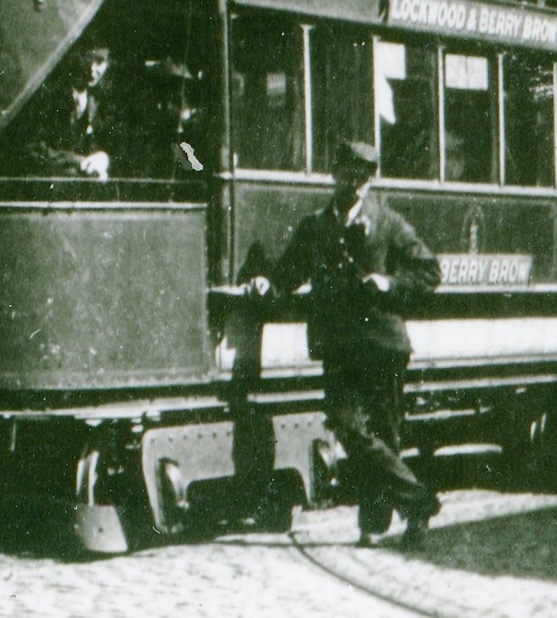
An enlargement of the above photograph, showing the conductor in uniform jacket and kepi-style cap.
Motormen and conductors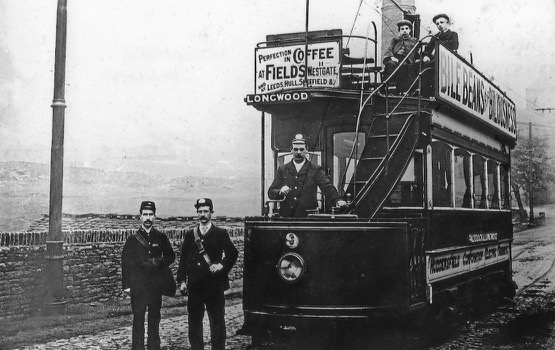
A conductor and his motorman, along with a postman (extreme left), pose with what appears to be a brand new Tramcar No 9, probably taken around the time that the Longwood route opened (25th February 1901). Author's Collection.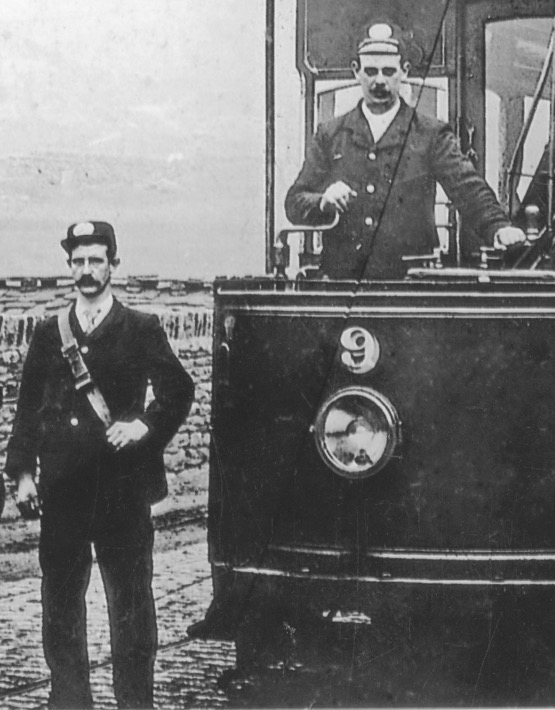
An enlargement of the above photograph showing the conductor and the motorman; both are wearing kepi-style caps that bear a large oval cap badge, almost certainly made of metal, and probably brass to match the buttons.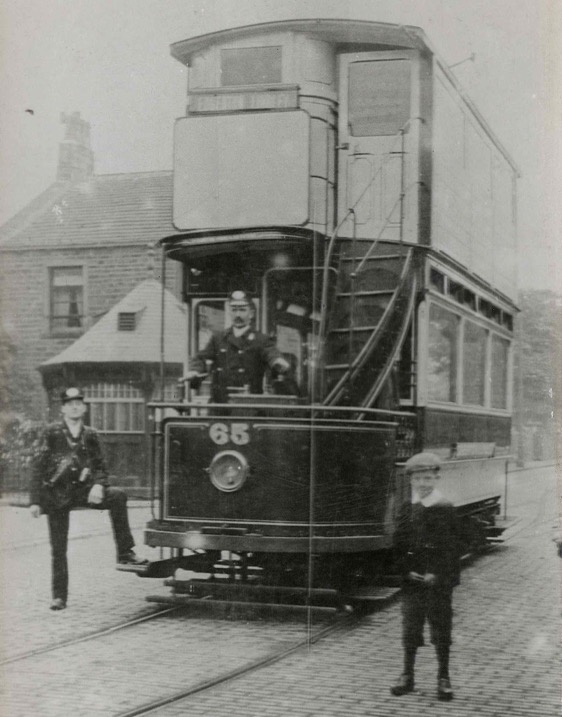
The crew of Tramcar No 65 at an unidentified terminus on an Edgerton-Lindley service — photo undated, but probably early Edwardian given the pristine condition of the vehicle, which entered service in 1903. Both men are wearing kepi-style caps bearing a prominent oval cap badge.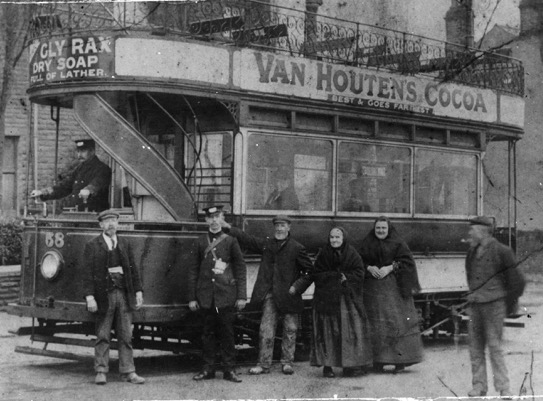
Tramcar No 54 on a service to Crossland Moor — photo undated, but probably taken around 1903/4. Photo courtesy of the National Tramway Museum.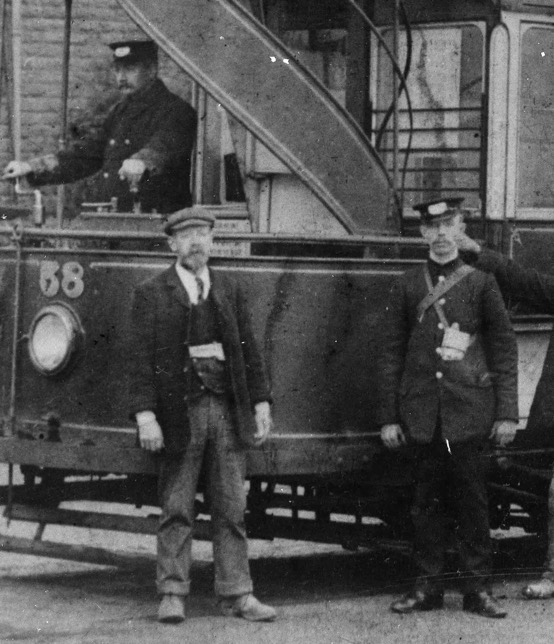
An enlargement of the above photograph showing the motorman, in his double-breasted greatcoat, and the conductor, in his single-breasted jacket. Although the large oval cap badge is still in evidence, the caps are now a more modern tensioned-crown type. The lack of any insignia on the conductor's uniform (other than the buttons) is clear to see.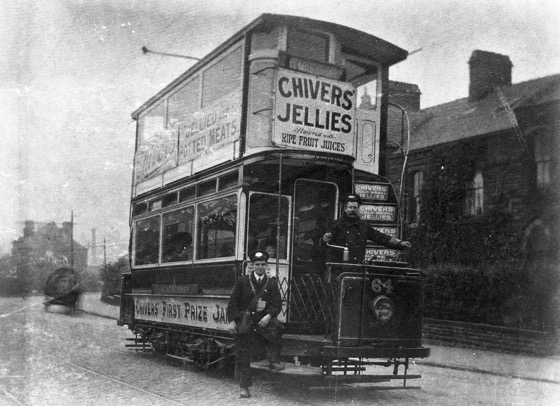
Tramcar No 64 on a service to Almondbury — photo undated, but definitely taken prior to 1907 when the wooden route boards seen on the side of the tram were dispensed with, and possibly as early as 1903/4 given its excellent condition. Photo courtesy of the National Tramway Museum. 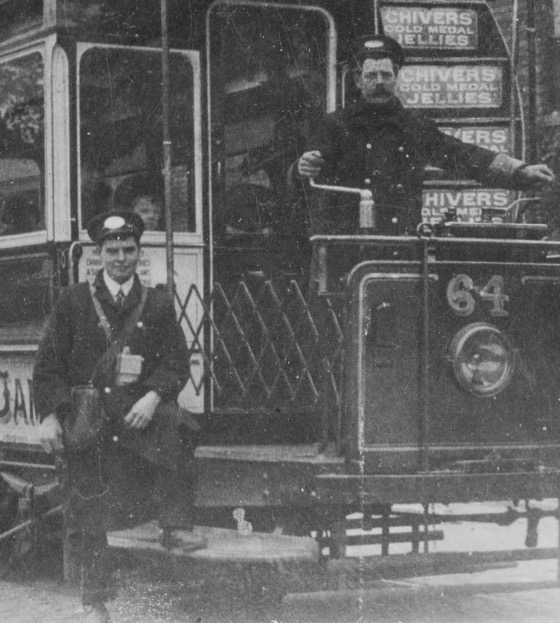
An enlargement of the above photograph showing the conductor and the motorman, both of whom are wearing double-breasted greatcoats, seemingly devoid of insignia.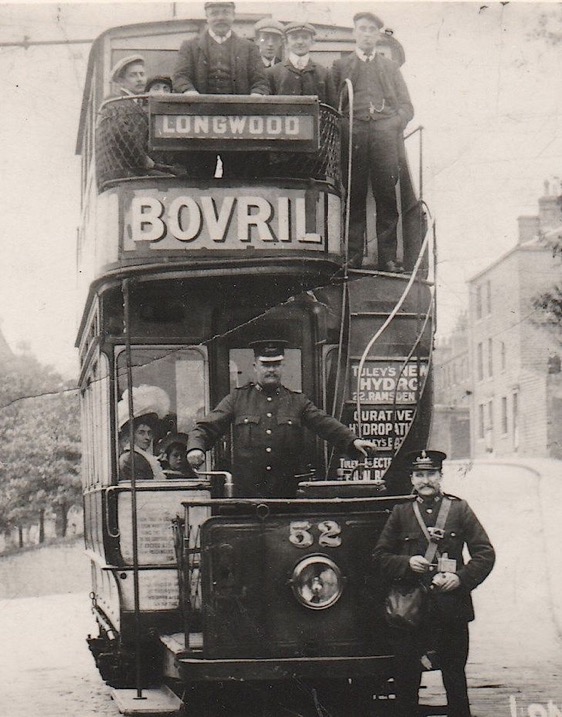
A shot of Tramcar No 52 taken at the Longwood terminus — photo undated, but from the style of the passenger's clothing, probably mid-to-late Edwardian. Both men are wearing script-lettering grade badges and a small municipal shield device (see below) on their caps, and a new style of single-breasted jacket with stand-up collars. Author's Collection.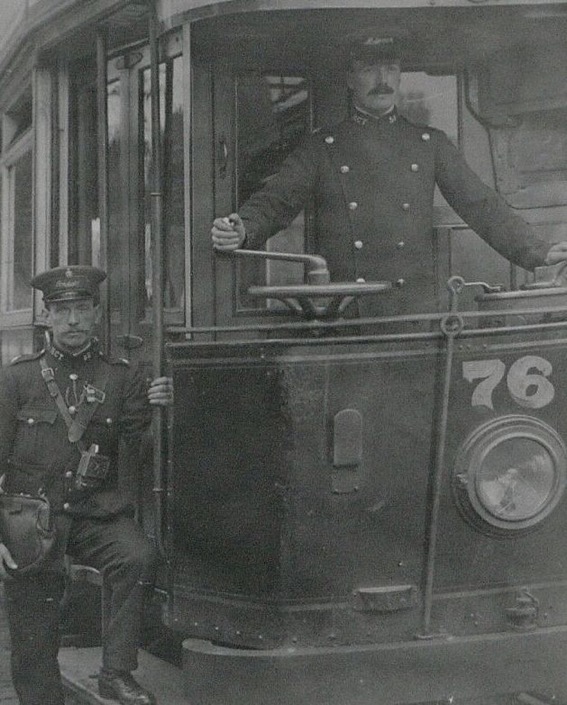
The crew of Tramcar No 76 pose with their vehicle — photo purportedly taken in 1913. The motorman is wearing a lancer-style tunic, whilst the conductor has the standard single-breasted jacket. Source unknown.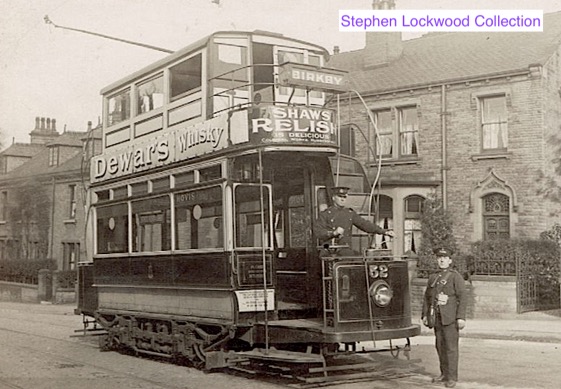
Tramcar No 52 standing at Wasp Nest Road loop, Fartown — photo undated, but probably taken shortly before the Great War. With thanks to Stephen Howarth.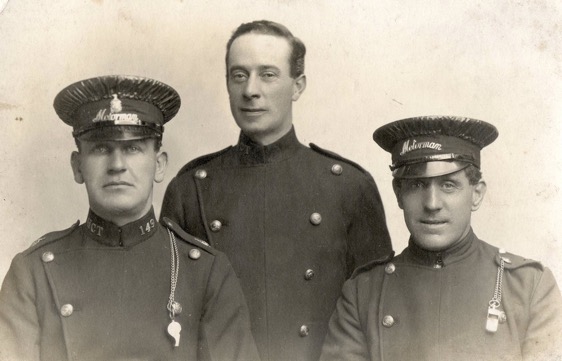
A studio portrait of three Huddersfield motormen. The individual on the left-hand side is Employee No 149, whereas the situation with the other two is unclear, as neither has a collar number. Photo undated, but probably taken shortly before the Great War. Author's Collection.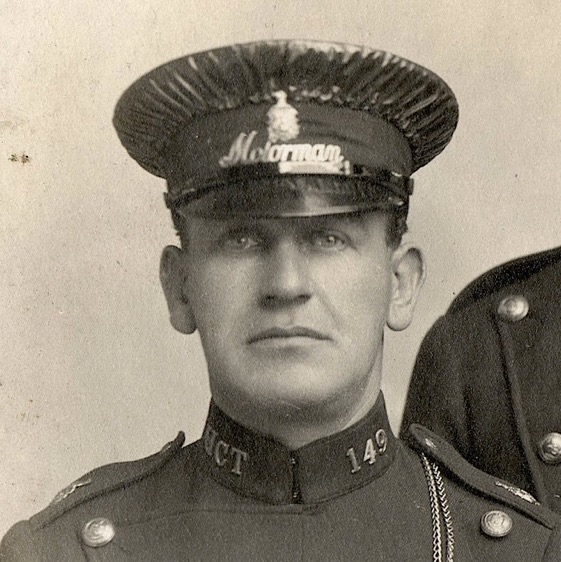
An enlargement of the above photograph showing Employee No 149 — a Huddersfield municipal-device badge appears on both epaulettes, as well as above his script-lettering grade badge. Unlike some later photographs, he is wearing a black rain cover on his cap.
General pattern script-lettering cap badges — 'Motorman' and 'Conductor' — of the type used by Huddersfield Corporation Tramways from circa 1907/8 onwards. Author's Collection.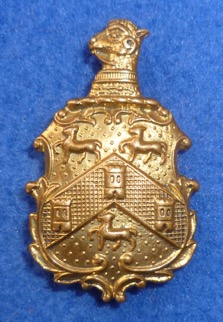
Huddersfield municipal-device badge — brass. This was worn on the jacket epaulettes, as well as on the caps, from around 1907/8 onwards. Author's Collection.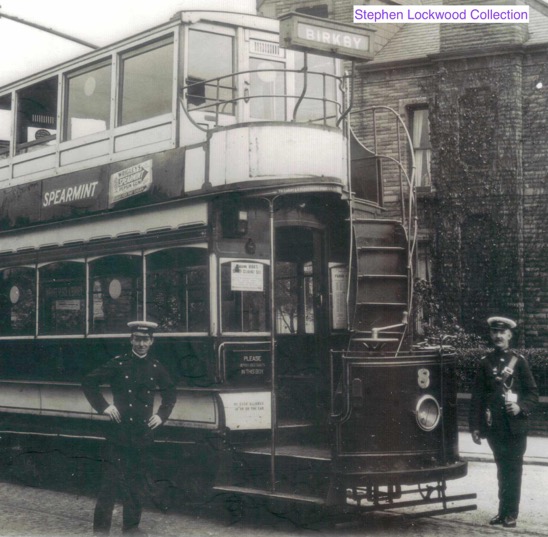
The crew of Tramcar No 8 pose for the cameraman in Spaines Road, Fartown — photo undated, but certainly taken after 1910 when the truck the vehicle is mounted on here was fitted, and possibly as late as 1912. Both men are wearing white ran-covers on their caps, so it would certainly have been summer.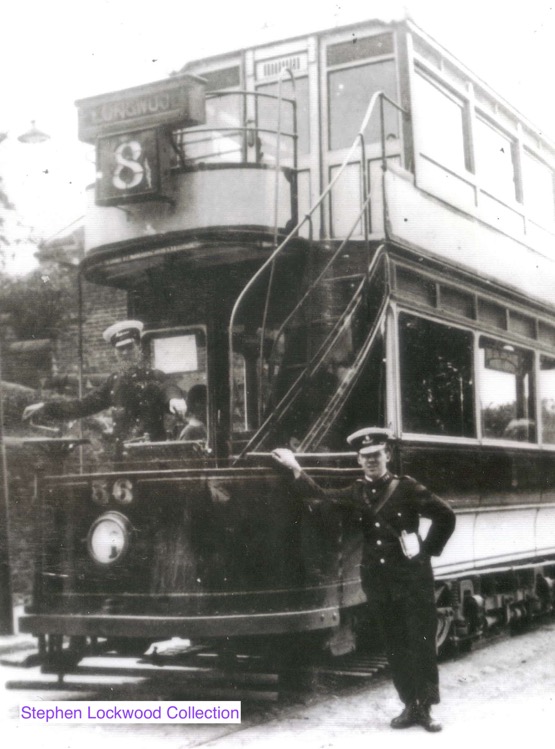
A motorman and a conductor with Tramcar No 56 on a No 8 service to Longwood — photo undated, but almost certainly taken in the mid-1920s, as this car was vestibuled by 1930.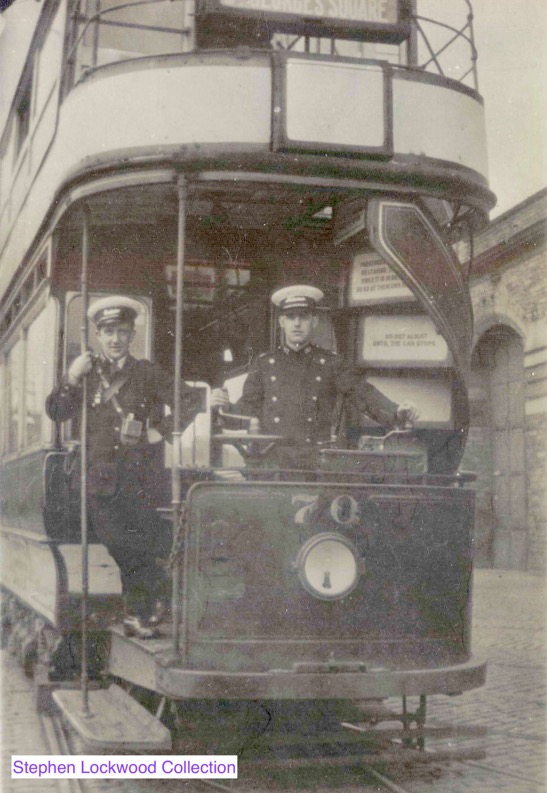
A conductor and a motorman with Tramcar No 70 outside Great Northern Street tram depot — photo undated, but probably taken during the 1920s as this car was vestibuled in 1930.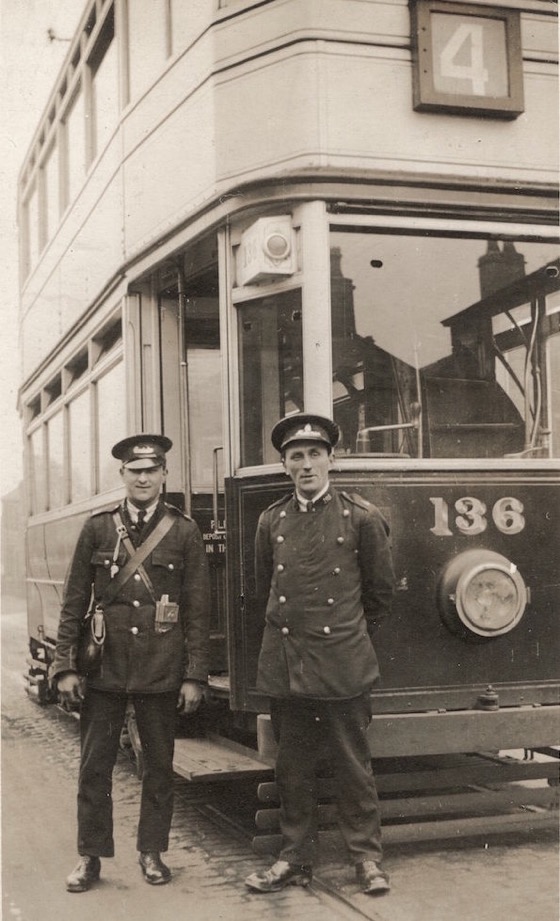
The crew of what is probably a brand-new Tramcar No 136, dating the shot to 1924 or shortly thereafter, pose for the camera with a No 4 service. Author's Collection.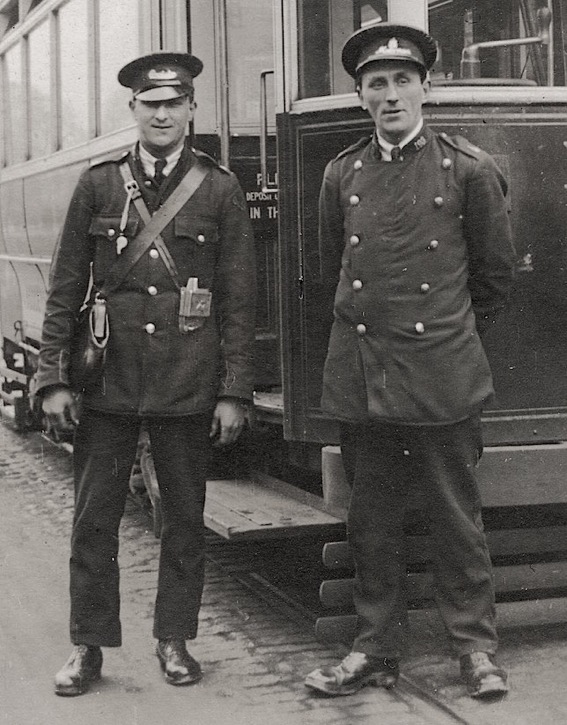
An enlargement of the above photograph showing the conductor and the motorman (Employee No 193) in more detail.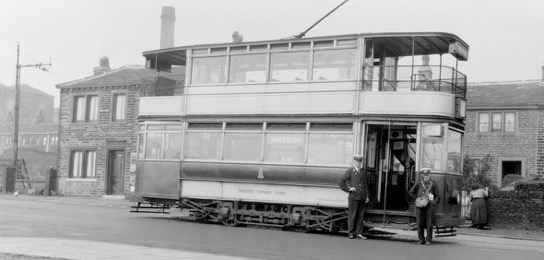
The crew of Tramcar No 71 stand with their charge at Outlane Terrace on 29th September 1933. Photographer, Dr H Nicol. With thanks to the National Tramway Museum. 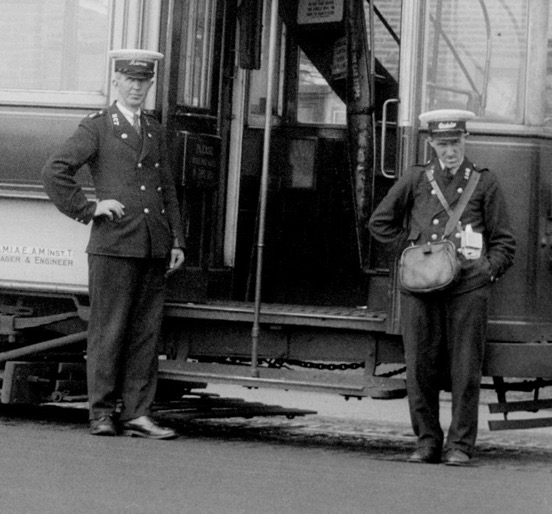
An enlargement of the above photograph showing the tramcar crew, both of whom are wearing double-breasted lapel jackets. The right-hand jacket collars bear 'H C T' system initials, with employee numbers carried on the left-hand side. 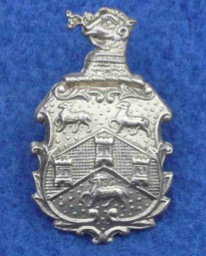
Huddersfield municipal-device badge — chrome. Chrome badges were probably worn on the jacket epaulettes from around the 1930s onwards.
Senior staff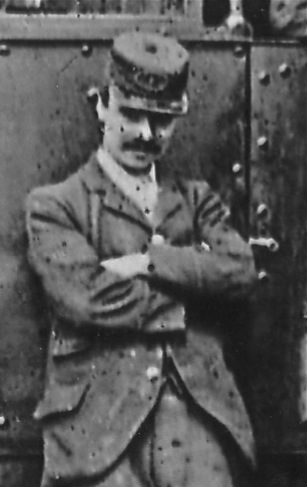
An enlargement of the 'Railway Street' steam tram photograph above, showing an individual who, given the pom pom on his cap, is almost certainly an inspector; the oval cap badge is very similar to the conductor's (in the same shot above), and both would appear to be of embroidered cloth.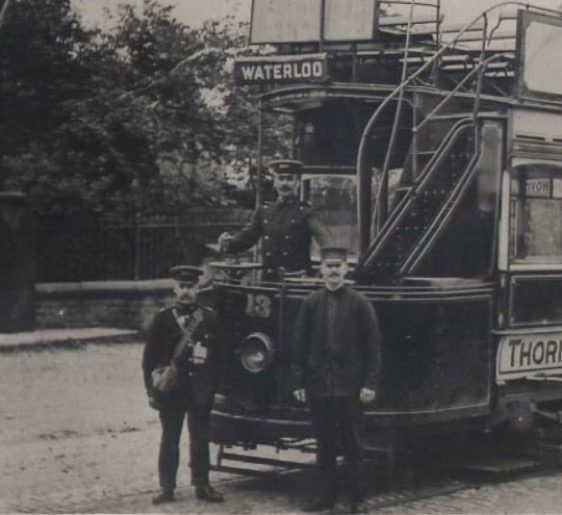
An inspector with the crew of Tramcar No 13 at the terminus at Outland - photo undated, but certainly taken no earlier than 1907 as the tram has destination boxes in the central saloon window (not shown). The inspector appears to be wearing a kepi or drooping-peak type cap, even though tramcar crews had by this time switched to tensioned-crown peaked caps.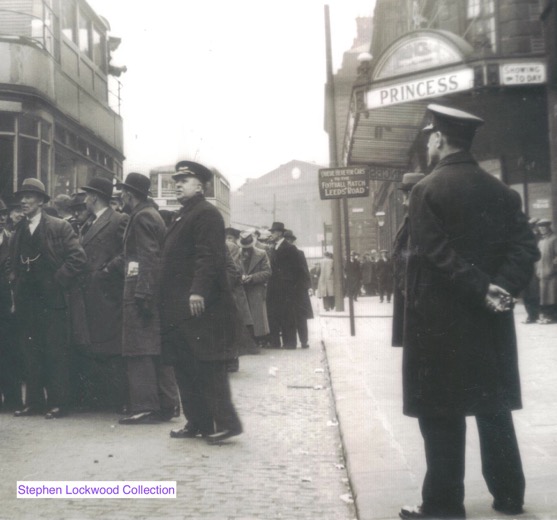
Two inspectors supervising Football Specials — photo undated, but probably taken in the 1930s.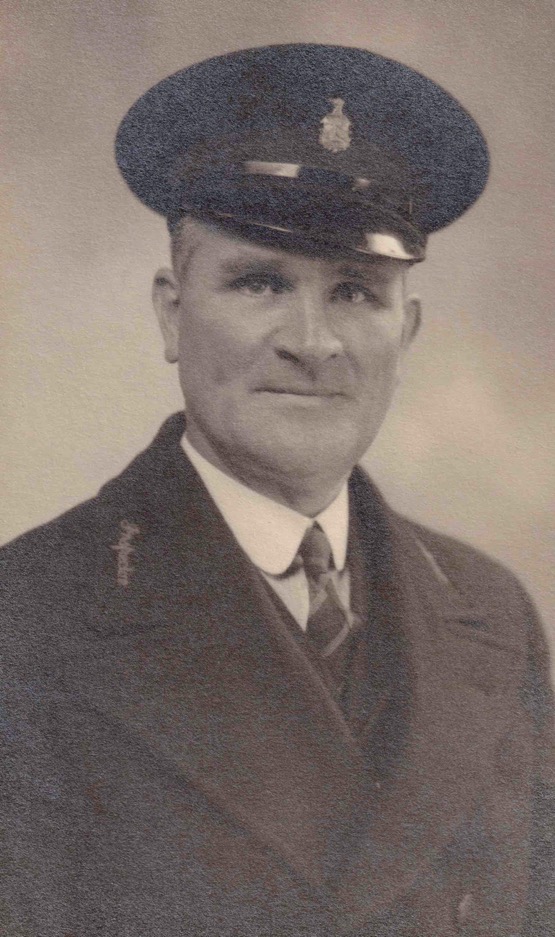
A studio portrait of a Huddersfield Corporation Transport inspector, taken on the 27th April 1945. Whilst this is almost five years after the tramway closed, the styles of the jacket and the cap most probably reflect those issued to this grade in the years immediately prior to closure.
Female staff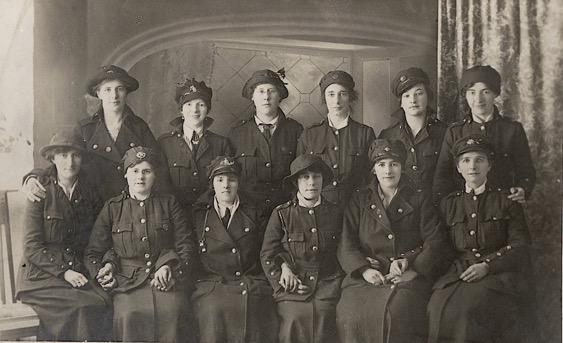
An excellent studio portrait of twelve Huddersfield Corporation Tramways Great War tram conductresses. Only five of them would appear to have the standard baggy cap with glossy peak, the rest are wearing a variety of informal headwear. Only two of the ladies have the standard municipal-device cap badge, the rest have some form of regimental badge. Author's Collection.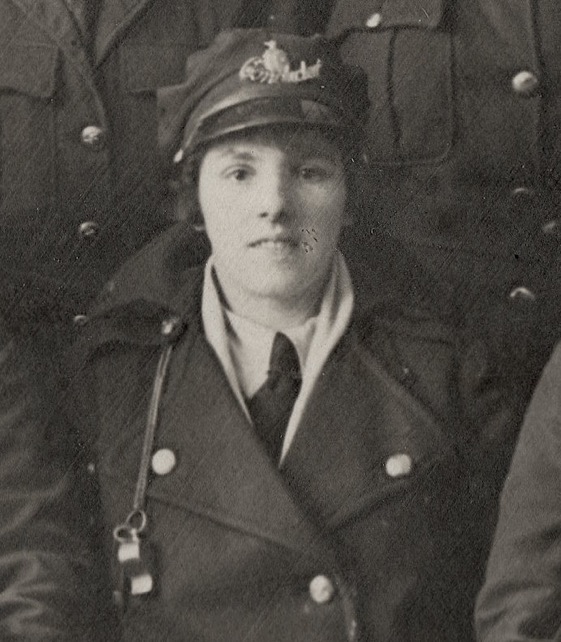
An enlargement of the above photograph showing the only lady who is wearing both a municipal-device badge and a grade badge on her cap.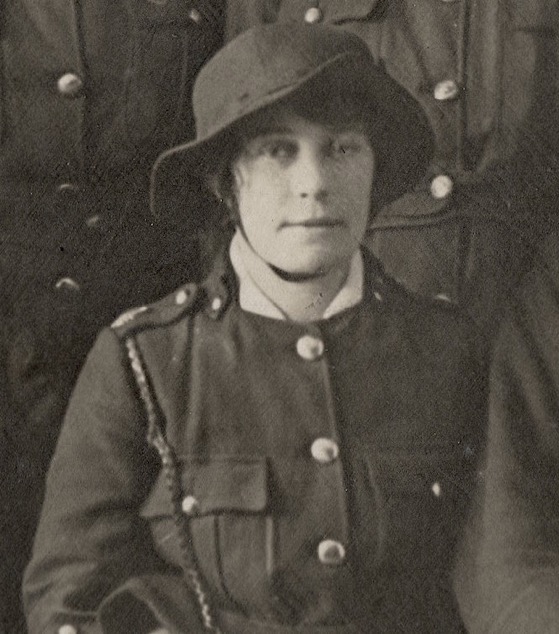
Another blow-up of the above studio photograph showing a lady in the standard tunic (with municipal-device badge on her epaulettes), but with an informal bonnet. The unusual button fastening arrangement of the collar is clear to see.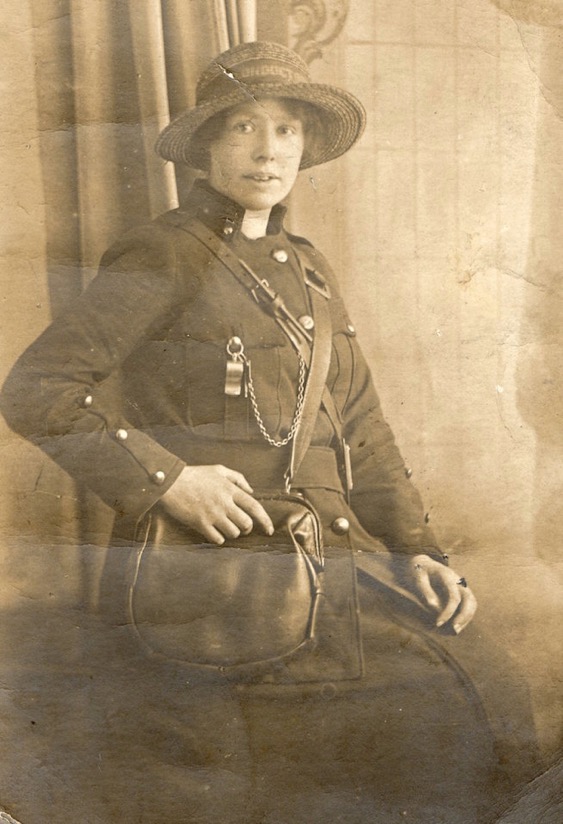
A Huddersfield Corporation Tramways Great War conductress. The back of the card carries the date '1918' and the name 'Ethel Dowson' and 'from Bessie'. Author's Collection.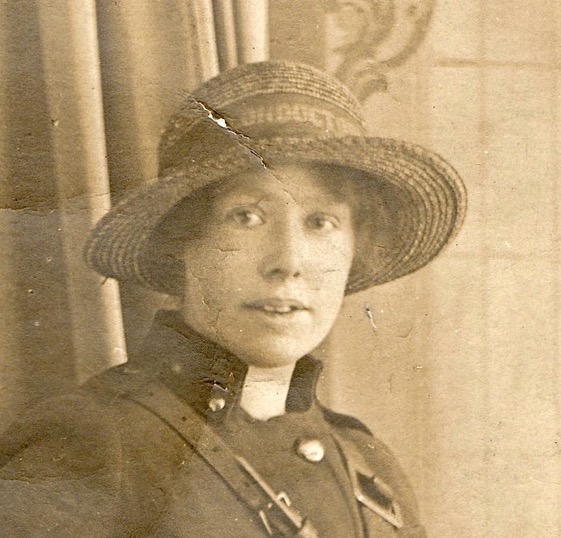
An enlargement of the above photograph showing the grade, which is carried on a hat band. The straw bonnet was more than likely just for summer wear, with a felt bonnet or baggy motor cap being substituted during the colder months.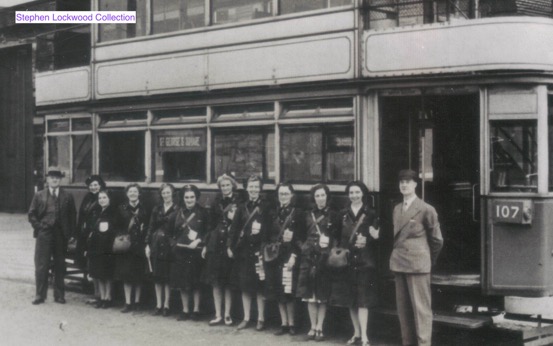
A group of conductresses photographed on the 1st July 1940, some two days after the last tram ran. They appear to be wearing one-piece, button-up smocks and berets. The General Manager (H C Godsmark) is on the extreme right, with the Traffic Manager on the extreme left.